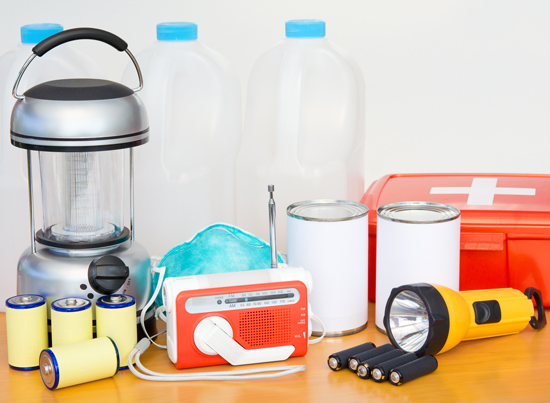It's a New Day in Public Health.
The Florida Department of Health works to protect, promote, and improve the health of all people in Florida through integrated state, county, and community efforts.
Making a Disaster Supply Kit
Contact Us
- 904-253-1270
-
Fax
904-253-2741 -
Mailing Address
921 N. Davis St.
Bldg. A, Suite 251
Jacksonville, FL 32209
A disaster supply kit for your home or an evacuation should include items in six basic areas:
- Water
- Food
- First aid supplies and medications
- Clothing and bedding
- Tools and emergency supplies
- Important family documents

- Tips for Making Your Kit
- Tips for Water and Food Supplies
- Tools and emergency supplies
- Clothing and bedding supplies
- First aid kits for your home and cars
- Important Family Documents
- Keep loose items in airtight plastic bags.
- Gather the kit’s items in easy-to-carry containers or duffle bags. Put kit within reach of your most often used exit.
- Check and update your kit based on family needs at least once a year.
- A normally active person needs to drink at least two quarts of water daily. Heat and intense activity can double this amount. Children, nursing mothers, and those with special needs may require more.
- Food preparation and sanitation require another two quarts (minimum) per person daily.
- Purchased bottled water that has been sealed is best for storage. It meets FDA guidelines for food, is not as vulnerable to temperature changes as unsealed water and has no shelf life. (Some bottles do have expiration dates, but this is mainly for inventory control.)
- If for any reason you must disinfect water, use unscented bleach in the ratio of 8 drops per gallon, about 1/8 teaspoon, and let the mixture sit 30 minutes before use.
- Choose compact, lightweight foods that do not require refrigeration, cooking, or preparation and foods that use little or no water.
- Hand washing with soap and water is extremely important. However, in the event water for hand washing is unavailable, use alcohol-based sanitizer.
DOH-Duval recommends at least a three-day supply of food and water in your kit:
- One gallon of water per person per day
- Ready-to-eat canned meats, fruits and vegetables
- Staples (salt, sugar, pepper, spices, etc.)
- Powdered milk and canned juices
- High-energy snacks and comfort/stress foods
- Food for infants and individuals with special needs
- Pedialyte (to restore hydration if needed)
- Paper cups, napkins, plates and plastic utensils
- Non-electric can opener, utility knife
- Cash or traveler’s checks, coins
- Map of the area for locating shelters
- Battery-operated radio and flashlight, extra batteries
- Fire extinguisher
- Pliers and shut-off wrench to turn off household water and/or gas
- Compass, signal flare, whistle and tube tent
- Plastic sheeting, storage containers, and bucket with tight lid
- Plastic garbage bags and ties for sanitation
- Tape (duct, masking)
- Candles and Matches in a waterproof container
- Paper, pencil
- Needles, thread
- Medicine dropper
- Aluminum foil
- Toilet paper, moistened towelettes, and towels
- Soap, liquid detergent, disinfectant, and unscented household chlorine bleach
- Feminine supplies and personal hygiene items
- Infant supplies (diapers, bottles, and pacifiers)
- At least two complete changes of clothing and footwear per person
- Sturdy shoes, work boots, hats, and gloves
- Blankets or sleeping bags and pillows
- Rain gear
- A three-day supply of each person’s vital medications
- Prescription drugs in original packaging (bottles)
- Sterile adhesive bandages in assorted sizes
- 2-inch and 4-inch sterile gauze pads (4–6)
- 2-inch and 3-inch sterile roller bandages (3 rolls)
- Triangular bandages (3)
- Latex gloves (at least 2 pairs)
- Cleansing agent, soap, and moistened towelettes
- Antiseptic and antibiotic ointment
- Petroleum jelly or other lubricant
- Assorted sizes of safety pins
- Scissors, tweezers, needle, and thermometer
- Tongue depressors (2)
- Non-prescription drugs
- Aspirin or non-aspirin pain reliever
- Anti-diarrhea medication, antacid, and laxative
- Syrup of Ipecac (use to induce vomiting if advised by the Poison Control Center)
- Activated charcoal (use if advised by the Poison Control Center)
- Sunscreen
- Mosquito repellent, with DEET when appropriate
- Extra prescription glasses, sunglasses, and/or contact lenses
- Hearing aid and batteries
- Personal items required to perform basic daily functions
Copies of the following important family documents in a waterproof, portable container within kits:
- Insurance policies
- Contracts and deeds
- Stocks and bonds
- Social Security cards and passports
- Immunization records and prescriptions
- Bank account numbers
- Credit card account numbers and company names and telephone numbers
- Inventory of valuable household goods
- Family records (birth, marriage, death certificates) and wills
- Current photographs of family members



Connect with DOH